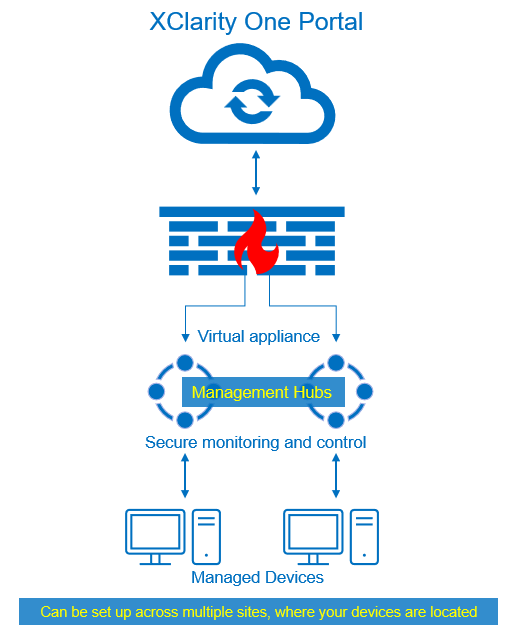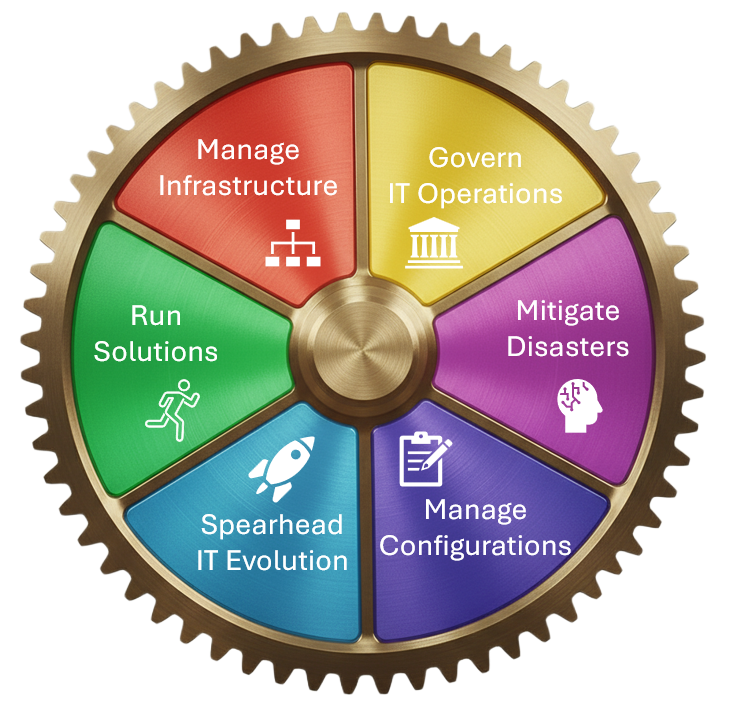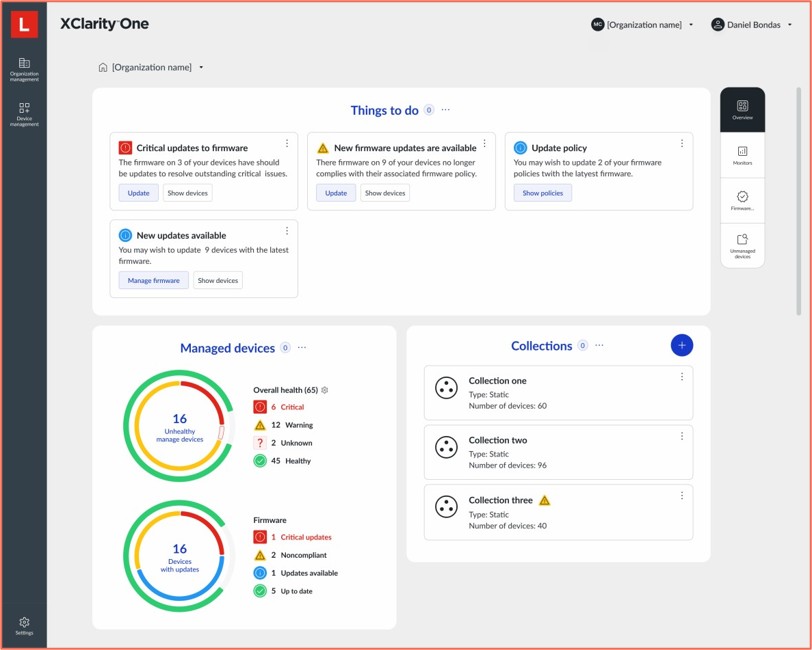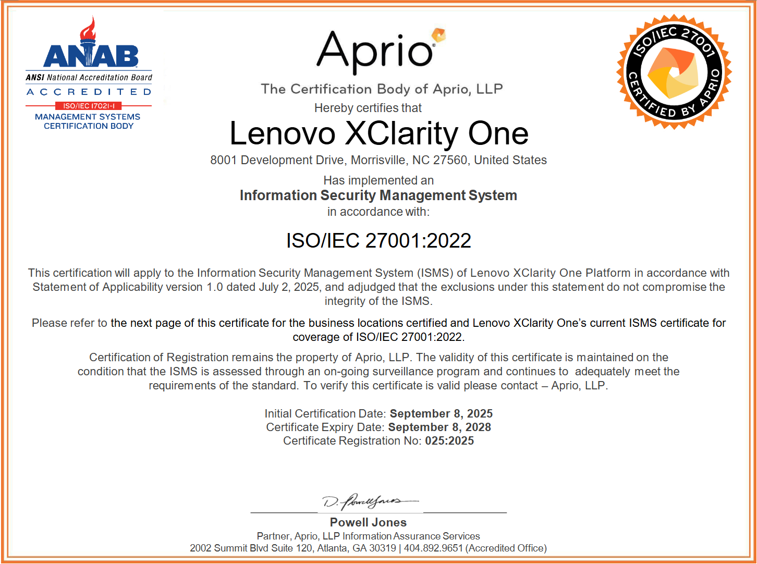Author
Updated
5 Nov 2025Form Number
LP2327PDF size
9 pages, 1.2 MBAbstract
In an era defined by digital transformation, the importance of a robust, efficient, and secure IT infrastructure cannot be overstated. IT Operations (ITOps) teams are the unsung heroes responsible for ensuring this infrastructure runs smoothly, managing everything from servers and storage to networking and security. As environments become more complex, encompassing hybrid clouds and edge computing, traditional management tools struggle to keep up. This is where Lenovo XClarity One steps in, a revolutionary hybrid cloud-based Management-as-a-Service (MaaS) platform that serves as a key component of modern ITOps, simplifying and automating infrastructure management from the edge to the cloud.
What is ITOps
ITOps, or IT Operations, is the management of an organization's IT infrastructure to ensure services run smoothly and efficiently. Its functions include managing hardware, software, networks, data centers, and user support, as well as performing tasks like proactive maintenance, monitoring, and incident response. ITOps also includes governing IT operations and playing a key role in spearheading IT evolution. The goal is to maintain and improve IT service delivery in alignment with business needs and to manage complex and evolving IT environments.
Figure 1. Key Aspects of ITOps
The Purpose of Lenovo XClarity One
At its core, Lenovo XClarity One is designed to provide unified, cloud-based management for on-premises data center infrastructure. It serves as a centralized platform that orchestrates deployment, monitoring, and maintenance across Lenovo's hardware ecosystem, including servers, and edge devices. Unlike traditional tools that often require fragmented setups, XClarity One leverages a hosted cloud architecture to deliver flexibility, scalability, and speed without the hassle of complex infrastructure configurations.
The platform's primary goal in the near future is to anticipate IT needs proactively, using AI to identify potential issues before they escalate into costly downtimes. For growing enterprises, this means transforming reactive ITOps into a predictive, automated process that spans from edge computing to cloud environments. By collecting inventory, incidents, and service data through lightweight on-premises management hubs, XClarity One ensures low-latency responses and secure data handling, making it ideal for distributed setups like multi-site data centers or remote edge locations.
In essence, its purpose aligns perfectly with the demands of modern ITOps: reducing complexity, accelerating response times, and enhancing system availability. Whether you're managing ThinkSystem servers for mission-critical workloads or ThinkEdge devices for IoT data processing, XClarity One acts as the glue that unifies these elements into a cohesive, manageable whole.
Figure 2. XClarity One Dashboard
Key Features Driving Innovation
What sets Lenovo XClarity One apart are its robust features, infused with cutting-edge AI and designed for seamless hybrid operations. Designed for unified systems management across supported Lenovo devices, Lenovo XClarity One improves operational efficiency and secures your infrastructure. Building on this foundation, XClarity One is developing AI-powered Smarter Support, with future capabilities set to include advanced predictive maintenance and intelligent analytics. This will empower your infrastructure with enhanced performance, reliability, and efficiency by anticipating needs before they arise.
The secure management hub forms the backbone of its architecture. It is deployed as a virtual appliance on-premises (supporting VMware ESXi, Linux/Nutanix, or Microsoft Hyper-V), across multiple sites, where your devices are located, to provide fast response times, low latency, and data security. It bridges local devices to the cloud-based portal without exposing them directly to the internet, adhering to a Zero Trust model. Features like role-based access controls, two-factor authentication, and audit logging ensure granular security, while customizable dashboards offer real-time insights into health, alerts, firmware updates, and resource usage.
Lenovo XClarity One provides a modern, intuitive interface to manage and monitor your management hubs and managed devices.
- Dashboards that highlight items in your organization requiring immediate attention.
- Summary views of the health of your organizations, hubs, and managed devices.
- Summary and detailed views of component health, asset inventory, and warranty status for your devices across multiple sites.
- Aggregation of critical alerts and events, with event forwarding to external applications.
- Lifecycle control for managed devices using templates (including firmware updates and device settings configuration).
- Remote server and remote console access for management hubs and managed devices.
- Usage data and trends, such as processor and memory utilization, power consumption, and processor temperature.
- Automatic problem notification to Lenovo Support using Call Home.
Lastly, and notably, XClarity One can be installed flexibly. Today this allows XClarity One to be hosted in the Lenovo cloud with on premise management hubs or as a fully on-premises solution.
The Value Proposition: Efficiency, Security, and Cost Savings
The true value of Lenovo XClarity One lies in its ability to deliver tangible benefits that directly impact the bottom line. By automating routine tasks—such as firmware compliance policies, alert aggregation, and configuration templates—it frees ITOps teams from manual drudgery, allowing them to focus on strategic initiatives. Organizations report reduced downtime through proactive AI-driven insights, which can prevent failures and extend hardware lifespan, ultimately lowering service costs.
From a cost perspective, the per-endpoint subscription model (with 1-, 3-, or 5-year options) ensures scalability without upfront capital expenditure. Furthermore, the platform's future open APIs and SDKs will allow for seamless, upward integration into your existing tech stack, eliminating vendor silos and integration headaches. The ultimate result for enterprises: faster time-to-value, enhanced by powerful features like memory predictive failure analysis and AI-customizable reporting for true data-driven decision-making.
Security is a major value driver in an era of escalating cyber threats. With ISO 27001:2022 certification and features like OTP (one-time password) authentication, XClarity One minimizes attack surfaces and ensures compliance with standards like NIST SP 800-131A. This risk mitigation enhances resiliency, providing peace of mind for businesses handling sensitive data.
Figure 3. XClarity One ISO27001 Certification
ISO/IEC 27001 is the world’s standard for information security management systems (ISMS) and their global requirements. Certification is covered by more than a dozen standards in the ISO/IEC 27000 framework.
The certification involves an independent audit to verify that Lenovo’s ISMS meets the ISO 27001 standard, providing benefits such as increased trust, regulatory compliance, competitive advantages, and reduced risks of data breaches.
ISO certification enables organizations of all sectors and sizes to manage the security of financial information, intellectual property, employee data and information entrusted by third parties.
Lenovo XClarity One in the cloud is the ideal solution for small to medium businesses (SMBs) and Managed Service Providers (MSPs) who demand enterprise-grade IT capabilities without the heavy upfront investment and operational overhead. It drives efficiency across three critical vectors: Cost, Time, and Operations.
The advantages of leveraging this Management as a Service (MaaS) solution are:
-
Total Maintenance Offload: Lenovo assumes full responsibility for hosting, managing, and maintaining the entire XClarity One environment for you.
-
Always Current & Secure: New software releases, security fixes, and firmware updates are installed immediately upon release, ensuring your infrastructure is always running on the latest, most secure foundation.
-
Proactive Issue Resolution: Critical customer fixes are installed as quickly as possible based on severity, backed by High Service Level Objectives (SLOs) for reliability.
-
Predictable Cost Model: You gain powerful functionality without the large capital expenditure, shifting IT management to a predictable, scalable operating expense.
Next Level Device Data Security
The XClarity One portal and the locally installed management hubs store hardware-specific data for all managed devices, including serial numbers, UUIDs, IP addresses and host names, hardware and firmware inventory, drive health, warranty, alerts and events raised by the devices, and usage and predictive failure analysis metrics.

Figure 4. XClarity One Architecture
Hardware data is transferred from the managed devices to the management hub and then to the XClarity One portal using HTTPS. Managed devices are not directly connected to the XClarity One portal.
Access to device data is restricted to users that have access to your organization, including service agents. The Lenovo XClarity Support team has administrative access to the XClarity One portal using internal identity management practices and role-based access control. All access to data is logged and audited.
Important:
- Device credentials are stored only on the management hubs in your data center. Device credentials are not stored in the cloud.
- Business and application-level data is never collected or stored on the management hubs or in the cloud.
Infrastructure Management as a Cornerstone of ITOps
Infrastructure management is the bedrock of ITOps, encompassing everything from hardware provisioning to performance monitoring and security enforcement. Lenovo XClarity One positions itself as a cornerstone by providing a unified lens through which ITOps teams can oversee their entire infrastructure ecosystem. In traditional setups, managing servers often involves multiple tools, leading to inefficiencies and blind spots. XClarity One eliminates this fragmentation by centralizing control, offering automatic discovery of devices and at-a-glance status views.
Its relation to ITOps is profound. Future integration of AI for predictive maintenance and anomaly detection shifts ITOps from firefighting to strategic planning. For instance, real-time monitoring of processor usage, power consumption, and temperature trends allows for proactive optimizations, ensuring high availability in critical sectors like healthcare or finance. In hybrid cloud scenarios, it bridges on-premises assets with cloud orchestration, supporting edge-to-cloud workflows that are essential for modern distributed computing.
As a cornerstone, XClarity One enhances ITOps agility. Features like remote access and future automated support notifications reduce mean time to resolution (MTTR), while life-cycle management ensures compliance and updates without disrupting operations. This holistic approach not only boosts reliability but also aligns with ITOps objectives of cost control, scalability, and innovation. For IT architects, it's a tool that fosters collaboration across teams, providing role-based interfaces that cater to administrators, engineers, and executives alike.
Moreover, in the context of emerging technologies like AI and IoT, XClarity One's support for ThinkAgile hyperconverged systems and ThinkEdge servers makes it indispensable. It enables secure, efficient management of AI-ready infrastructure and by anticipating needs and automating responses, it solidifies infrastructure management as the foundation upon which successful ITOps are built.
Conclusion: Embracing the Future with XClarity One
Lenovo XClarity One isn't just a management tool—it's a strategic enabler for the future of ITOps. By blending AI intelligence, deployment flexibility, and robust security, it addresses the pain points of infrastructure management head-on, delivering efficiency, resilience, and value that propel businesses forward. As organizations navigate the complexities of digital transformation, adopting platforms like XClarity One will be key to staying competitive.
If you're ready to elevate your ITOps, explore Lenovo's resources or sign up for a free 1 year trial subscription by contacting us on the XClarity One product page. The future of infrastructure management is here, and it's smarter than ever.
Trademarks
Lenovo and the Lenovo logo are trademarks or registered trademarks of Lenovo in the United States, other countries, or both. A current list of Lenovo trademarks is available on the Web at https://www.lenovo.com/us/en/legal/copytrade/.
The following terms are trademarks of Lenovo in the United States, other countries, or both:
Lenovo®
ThinkAgile®
ThinkEdge®
ThinkSystem®
XClarity®
The following terms are trademarks of other companies:
Linux® is the trademark of Linus Torvalds in the U.S. and other countries.
Microsoft® and Hyper-V® are trademarks of Microsoft Corporation in the United States, other countries, or both.
Other company, product, or service names may be trademarks or service marks of others.
Configure and Buy
Full Change History
Course Detail
Employees Only Content
The content in this document with a is only visible to employees who are logged in. Logon using your Lenovo ITcode and password via Lenovo single-signon (SSO).
The author of the document has determined that this content is classified as Lenovo Internal and should not be normally be made available to people who are not employees or contractors. This includes partners, customers, and competitors. The reasons may vary and you should reach out to the authors of the document for clarification, if needed. Be cautious about sharing this content with others as it may contain sensitive information.
Any visitor to the Lenovo Press web site who is not logged on will not be able to see this employee-only content. This content is excluded from search engine indexes and will not appear in any search results.
For all users, including logged-in employees, this employee-only content does not appear in the PDF version of this document.
This functionality is cookie based. The web site will normally remember your login state between browser sessions, however, if you clear cookies at the end of a session or work in an Incognito/Private browser window, then you will need to log in each time.
If you have any questions about this feature of the Lenovo Press web, please email David Watts at [email protected].



